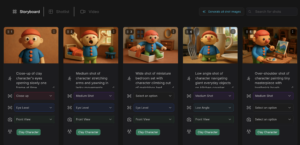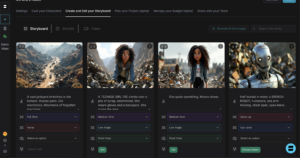Introduction
In the fast-evolving world of film, advertising, and animation, storyboarding remains a critical step in visualizing and planning creative projects. However, traditional storyboarding methods can be time-consuming and expensive. That’s where AI storyboarding tools come in, offering a faster, more efficient way to bring your ideas to life. In this article, we’ll dive into a detailed comparison of two popular options: Shai vs FrameForge, exploring their features, pricing, and overall effectiveness as AI storyboard tools.
Shai is emerging as a leading AI storyboard generator, designed to streamline the pre-production process with its intuitive interface and powerful AI capabilities. FrameForge, on the other hand, has been a long-standing player in the previsualization software space, offering a robust set of tools for filmmakers and visual artists. This Shai vs FrameForge comparison will help you determine which platform best suits your needs for AI-powered storyboarding. Whether you’re an ad agency, animation studio, or e-learning developer, understanding the strengths of each tool is crucial for optimizing your workflow. Read on to discover how Shai and FrameForge stack up in the realm of AI storyboard software and which one offers the best solution for your creative projects.
Shai vs FrameForge features at a glance

Shai’s intuitive interface where users can upload a script and generate visual storyboards, complete with scene sequencing, shot duration, and voiceover options — all in one platform.
Let’s take a quick look at how Shai and FrameForge stack up in terms of features. Shai is an AI storyboard generator designed to streamline the pre-production process with AI-powered tools. FrameForge, developed by Innoventive Software, LLC, offers a virtual film studio environment for previs and storyboarding. Here’s a breakdown of their key features:
Primary Purpose
Shai: AI-driven storyboard creation, concept development, and animatic generation.
FrameForge: Previsualization and virtual filmmaking with detailed set design and camera simulation.
Speed
Shai: Rapid storyboard generation from scripts in minutes.
FrameForge: Real-time set and camera adjustments, but requires manual setup.
Ease of Use
Shai: User-friendly interface with intuitive AI prompting.
FrameForge: Steeper learning curve due to its comprehensive feature set and detailed controls.
Output Quality
Shai: High-quality, consistent storyboard frames with AI model optimization.
FrameForge: Optically accurate virtual film studio with customizable actors and objects.
Pricing
Shai: Offers a free trial and tiered subscription plans starting at $12/month.
FrameForge: Offers both Core and Pro editions with different pricing structures.
Best For
Shai: Filmmakers, VFX supervisors , Ad agencies, animation studios, and e-learning developers seeking fast, AI-enhanced storyboarding.
FrameForge: Filmmakers and VFX supervisors needing detailed previs with accurate camera and set simulations.
Why AI Storyboarding Matters
The integration of AI into storyboarding represents a significant shift in the creative industry. Traditional storyboarding is a time-consuming and often expensive process, requiring skilled artists and animators to manually create each frame. However, with the advent of AI storyboard software, this process can be streamlined, democratizing access to high-quality pre-visualization tools for a broader range of creators.
AI storyboarding offers several key benefits. Firstly, it drastically reduces the time required to create storyboards, potentially cutting weeks of work down to minutes. Secondly, it lowers the cost barrier, making professional-grade storyboarding accessible to indie creators, startups, and smaller production houses. Thirdly, it allows for rapid iteration and experimentation, enabling directors and creative teams to explore multiple visual concepts quickly. Finally, AI-powered tools can enhance creative control by providing consistent character and style representation throughout the storyboard. This is particularly relevant for industries such as advertising, animation, and e-learning, where clear and compelling visual communication is paramount. By leveraging an AI storyboard tool, professionals can focus more on refining their vision and less on the manual labor of creating storyboards.
Examples of AI Storyboards
AI storyboards are transforming how various industries visualize and plan their projects. By automating much of the initial creation process, teams can save significant time and resources while still achieving high-quality results. Here are a few examples of how AI storyboard software is being used today:
Ad Campaign Storyboarding

Consider an advertising agency tasked with creating a series of video ads for a new product launch. Traditionally, this would involve hiring storyboard artists to manually draw each scene, which can be a time-consuming and costly process. With an AI storyboard tool like Shai, the agency can upload the ad script and generate a complete storyboard in minutes. This allows them to quickly visualize different concepts, experiment with various shot compositions, and refine the visual narrative before investing in expensive video production. The time and cost savings can be substantial, allowing the agency to focus on other critical aspects of the campaign.
Animation Studio Previs

Animation studios often spend months in pre-visualization, creating detailed storyboards to guide the animation process. Using an AI storyboard generator can significantly accelerate this phase. For example, animators can input script excerpts and generate multiple storyboard options, exploring different character poses, camera angles, and scene layouts. This rapid iteration helps them refine their vision and make informed decisions about the animation’s visual style and pacing early on.
E-Learning Module Visualization
Creating engaging e-learning modules requires careful planning and visual storytelling. An AI storyboard tool can help e-learning developers quickly visualize the content and create a cohesive learning experience. Instead of relying on static images or text-heavy slides, developers can use AI to generate dynamic storyboards that illustrate complex concepts and scenarios. This not only enhances engagement but also ensures that the learning objectives are clearly communicated through visual means.
What Is Shai?

Shai’s intuitive interface where users can upload a script and generate visual storyboards, complete with scene sequencing, shot duration, and voiceover options — all in one platform.
Shai is an AI-powered storyboard generator designed to revolutionize pre-production for filmmakers, advertisers, animation studios, and e-learning developers. It allows users to upload a script and instantly generate a complete visual storyboard, dramatically accelerating the visualization process. Shai also functions as a powerful concept development tool, enabling the generation of visual concepts from initial story ideas by defining the desired tone, format, and video length. What sets Shai apart is its focus on speed and simplicity, offering a user-friendly experience that doesn’t require deep AI knowledge or complex prompt engineering. With features like script-based shot extraction, character and style control, and collaboration-friendly workflows, Shai empowers creative teams to stay focused on their vision. If you are ready to see how Shai can revolutionize your workflow, Start Creating Your Own AI Storyboards Now.
What Is FrameForge?
FrameForge, developed by Innoventive Software, LLC, is a previsualization and storyboarding software designed to help filmmakers and content creators plan their shots with precision. With a history dating back to 1991, Innoventive Software, based in San Diego, California, has earned accolades such as a Technical Achievement Emmy and a Lumiere Statuette for FrameForge’s contributions to pre-production visualization. FrameForge allows users to build virtual sets, incorporate actors and props, and experiment with camera angles and lighting to create detailed storyboards. FrameForge comes in two versions: Core and Pro, each offering a range of features to cater to different production needs. While FrameForge does not harness AI to generate storyboards, it provides tools for filmmakers to manually create and refine their visual plans in a virtual environment.
Key Differences: Shai vs FrameForge

Shai storyboard view showing AI-generated frames from uploaded script
While both Shai and FrameForge address the need for efficient storyboarding, they approach the task with fundamentally different philosophies. Shai is built as an AI storyboard generator from the ground up, leveraging advanced AI models to automate and accelerate the storyboarding process. It excels in quickly transforming scripts and ideas into visual sequences, offering intuitive controls for style and character consistency. FrameForge, on the other hand, is a previsualization software that focuses on recreating a physical film set within a virtual environment. This allows for precise camera placement, lighting design, and set planning, but it requires a more manual and technical approach.
AI-Driven Automation vs. Manual Precision
The core difference lies in automation versus manual control. Shai uses AI to generate storyboards rapidly, making it ideal for quick concept development and pre-production visualization. FrameForge emphasizes precision and control, allowing filmmakers to meticulously plan every aspect of a shot within a virtual set. This makes FrameForge more suited for projects where technical accuracy and detailed pre-planning are paramount.
Workflow and Complexity
Shai offers a streamlined workflow, enabling users to upload a script or input a concept and instantly generate storyboards. The platform’s intuitive interface and AI-driven features minimize the learning curve, making it accessible to users with varying levels of technical expertise. FrameForge, with its focus on virtual set design and camera simulation, involves a more complex workflow. Users need to build or import sets, position cameras and lights, and manually adjust various settings to achieve the desired shots. This requires a significant time investment and a deeper understanding of filmmaking techniques.
Collaboration and Accessibility
Shai is designed with collaboration in mind, allowing teams to easily share storyboards and gather feedback. Its cloud-based platform ensures accessibility from anywhere, facilitating seamless teamwork. FrameForge, while powerful, is typically used by individual artists or small teams working on-site, which can limit collaboration and accessibility. Shai’s AI-powered approach dramatically reduces the time and cost associated with traditional storyboarding, while FrameForge delivers detailed previsualization capabilities for technically demanding productions.
Why Shai Is Better for AI Storyboarding
While FrameForge offers a robust environment for previsualization, especially in terms of camera and equipment accuracy, Shai excels in rapid AI-driven storyboarding. Shai’s AI-powered storyboard generator allows users to upload scripts and instantly visualize entire scenes, cutting down pre-production time from weeks to minutes. This speed advantage is crucial for fast-paced projects and teams needing quick turnarounds. Furthermore, Shai’s focus on AI storyboarding software means its features, like script-based shot extraction and character/style control, are designed specifically for streamlining the storyboarding process. Unlike FrameForge, which requires a more hands-on approach to set up each shot, Shai automates much of the initial visualization, allowing creatives to focus on refining the narrative and visual style. The cost-efficiency of Shai, compared to traditional storyboarding methods or the more comprehensive (and potentially complex) FrameForge, makes it an accessible AI storyboard tool for indie creators, commercial studios, and larger teams alike. Shai’s collaboration-friendly workflow also enhances team dynamics, making it easier to share and iterate on storyboards, a critical feature in modern production environments.
Deep Dive Into Shai’s Features
Shai is packed with features designed to streamline the storyboarding process, leveraging AI to empower creative teams. Here’s a closer look at what makes Shai a powerful AI storyboard tool:
AI-Powered Storyboard Generator
At the heart of Shai is its AI-powered storyboard generator. Simply upload a script, and Shai instantly generates a complete visual storyboard, converting entire movie scripts, commercials, and short content into structured visual sequences. This feature alone can drastically reduce pre-production time, cutting weeks of manual work down to minutes. The AI identifies key moments and shots from the script, significantly speeding up the pre-visualization phase.
Concept Development Tool
Shai isn’t just for finished scripts; its concept development tool allows you to generate storyboards even from initial ideas. By defining the tone, format, and video length, you can tailor the AI storyboard generator to your specific creative needs. This is particularly useful in the early stages of project development, allowing for rapid visualization and exploration of different concepts.
Image-to-Video / Animatic Creation
Taking storyboarding a step further, Shai can turn generated storyboard frames into basic animated sequences, or animatics. This helps visualize the flow, pacing, and transitions early in the process, providing a dynamic representation of the final product. While FrameForge focuses on detailed previsualization within a virtual environment, Shai prioritizes quick animatic creation, allowing for faster iteration and feedback.
Script-Based Shot Extraction
Shai excels at automatically identifying key moments, shots, and beats directly from uploaded scripts. This feature drastically accelerates the pre-visualization phase, ensuring that no important scene is overlooked. By intelligently parsing the script, Shai ensures that the generated storyboards accurately reflect the narrative’s crucial elements.
Collaboration-Friendly Workflow
Shai is designed with team collaboration in mind. Storyboards can be easily shared with clients or team members, facilitating feedback and ensuring everyone is on the same page. While future plans include commenting, versioning, and real-time feedback loops, the current sharing capabilities make it a collaboration-friendly AI storyboard tool.
Shai vs FrameForge Pricing Comparison
When evaluating the cost-effectiveness of storyboarding tools, it’s essential to consider both the upfront price and the long-term value they provide. Shai offers a range of subscription options designed to cater to different needs and budgets. Shai’s pricing is structured around monthly subscriptions, which include a Free Trial, Basic at $12/month (Unlimited projects, 120 images, 13 videos), Freelance at $29/month (440 images, 44 videos), and Studio at $79/month (Animatics, priority export & support, 1400 images + 156 videos). FrameForge, on the other hand, offers both Core and Pro Editions, but accessing specific pricing details requires navigating their website, which can be challenging as their Shopify store may be unavailable. While FrameForge offers a 30-day money-back guarantee, Shai distinguishes itself by providing a transparent and accessible pricing model, coupled with AI-driven features that enhance speed and creative control. For those seeking an AI storyboard tool that balances affordability with robust functionality, Shai presents a compelling option.
Ready to see the value? Create Your First AI Storyboard Free and explore how Shai can revolutionize your pre-production process.
Conclusion: Shai vs FrameForge Final Verdict
In the landscape of AI storyboarding tools, the choice between Shai vs FrameForge depends largely on your specific needs and priorities. FrameForge, with its Emmy and Lumiere accolades, offers a robust environment for detailed previsualization, catering especially to filmmakers and VFX professionals who require precise control over camera equipment and set design. However, for those seeking a streamlined, AI-powered solution that rapidly transforms scripts into visual storyboards, Shai emerges as the superior choice. Shai’s focus on speed, ease of use, and collaborative workflows, combined with its affordable pricing, makes it an ideal AI storyboard tool for advertising agencies, animation studios, e-learning developers, and marketing teams aiming to enhance their pre-production processes. Ultimately, Shai empowers creative teams to visualize their stories faster and more efficiently. Ready to revolutionize your storyboarding process? Create Your First AI Storyboard Free with Shai today.